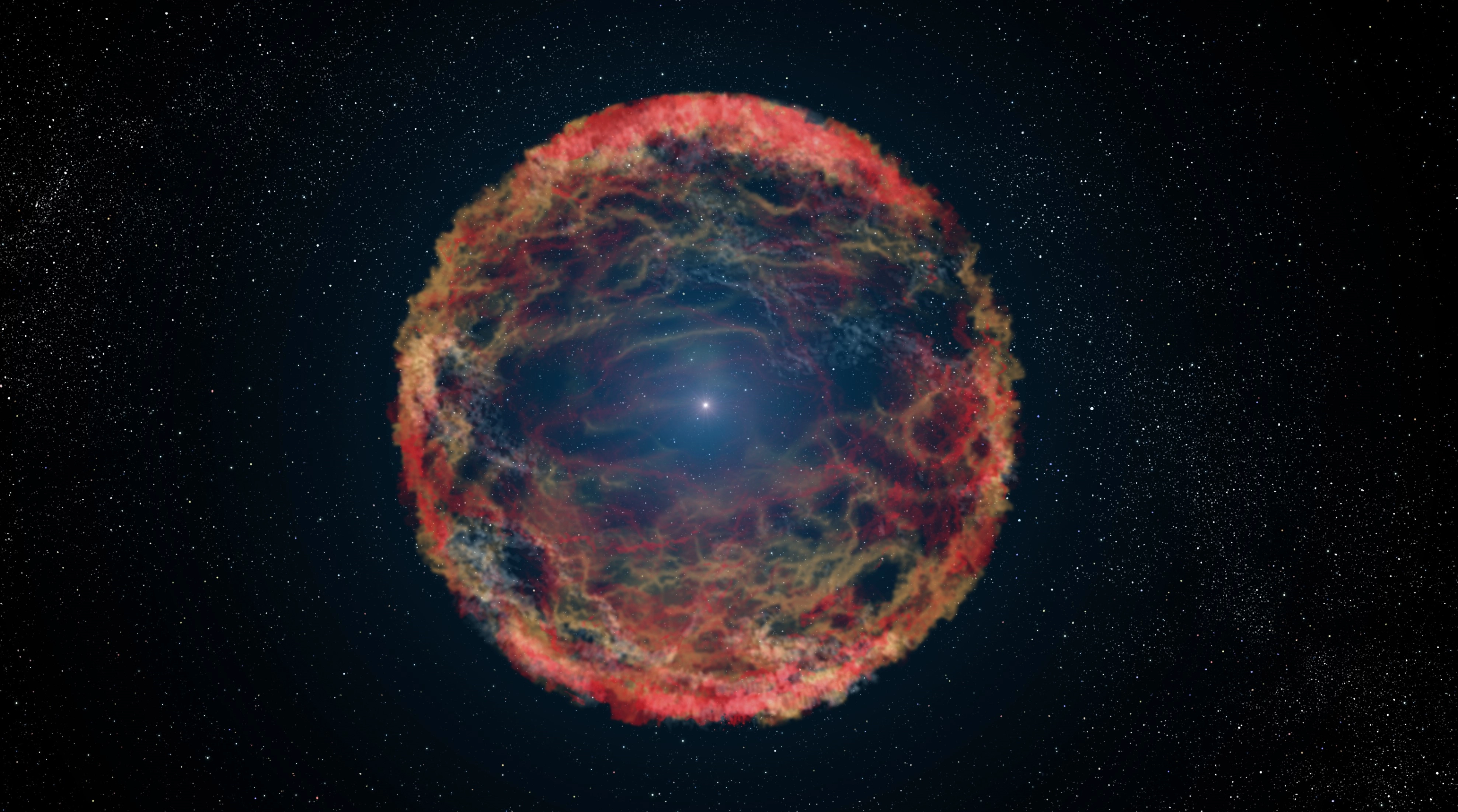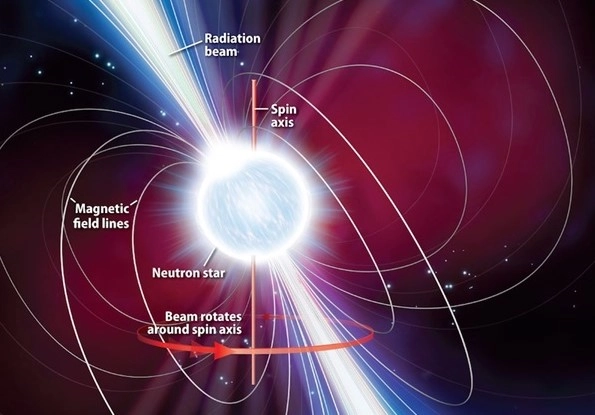Imagine the situation in which you sitting in your college observatory/laboratory, have been given in-charge of handling the data obtained by some instrument. Suddenly, you see it has started giving you strange signals. What if the instrument is a telescope pointed towards outer-space ? Feeling frisson, ain’t it? Whatif I tell you this isn’t just an imagination, but is based on a ‘true incident’?
The Story of Jocelyn Bell
In mid-1967, when thousands of people were enjoying the summer of love, a young PhD student at the University of Cambridge in the UK was helping to build a telescope. It was a poles-and-wires affair – what astronomers call a “dipole array”. It covered a bit less than two hectares, the area of 57 tennis courts. The formation of the telescope was completed by July. The student, Jocelyn Bell (now Dame Jocelyn Bell Burnell), became responsible for running it and analysing the data it churned out. The data came in the form of pen-on-paper chart records, more than 30 metres of them each day. Bell used to analyse them by eye.
In one of her analyses, she detected a strange signal. It was strange because it was not expected. The signal had a 1.337302088331-second period and 0.04-second pulse width. Initially, they(Bell and her advisor, Antony Hewish) thought it to be some noise, but this hypothesis had to be discarded, as the signal was coming from a particular direction.
It was clear that the signal was not random. It was coming from some source. The source was named LGM-1(Little Green Men) because the only other possibility they could think of was an extraterrestrial life. Have they made contact with aliens ? Were they receiving some signals from someone from another world ?

The Discovery of Pulsars
Sadly for science fictionists, the alien theory had to be discarded again, as the astronomers found another such signal in a different part of sky soon. It was later found that such signals were coming from many different parts of the sky. Since the signals had regular pulses with the same period, the source was named as ‘Pulsars’ (Pulsating Variables). What exactly were these pulsars? Have astronomers found something new in the sky? Or is it something we already knew ? Let’s see what were these sources.
It was the December of 1933. James Chadwick had discovered the existence of the neutral subatomic particle Neutron. In the meeting of the American Physical Society, two renowned men Walter Baade and Fritz Zwicky proposed the existence of Neutron Stars, in the attempt of explaining the events involved in a supernova explosion. Still, little work could be done on them as they were too faint to be detectable. Now, why am I discussing two very different topics here ? Do they have a connection between them ? Whatever it is, it’s gonna be really interesting, because the answer is ‘yes’. The discovered pulsars are none other than these neutron stars themselves. In fact, the discovery of these pulses by Jocelyn Bell was the first evidence of the predictions of Fritz Zwicky.
Sir Stephen Hawking has said in one of his books that making a name in the scientific community is very difficult these days. You need to have a name for claiming what’s yours. It’s really sad to know that the same incident happened then too. The 1974 Physics Nobel Prize was awarded to Antony Hewish for his work in radio astronomy, most importantly due to discovery of this pulsar. I want to claim boldly that the more deserving candidate Jocelyn Bell was left out! She could have been the first in her field to do so. Yea, there are some deep scars in history too!
 Jocelyn Bell (Burnell) pictured at the Mullard Radio Observatory in 1967 with the pulsar chart, left. Image courtesy of the Cavendish Laboratory. Pulses having a constant time-period can be easily seen. This is what led to the discovery of Pulsars. The recording were taken from PSR B1919+21 (obviously not known to them at that time).
Jocelyn Bell (Burnell) pictured at the Mullard Radio Observatory in 1967 with the pulsar chart, left. Image courtesy of the Cavendish Laboratory. Pulses having a constant time-period can be easily seen. This is what led to the discovery of Pulsars. The recording were taken from PSR B1919+21 (obviously not known to them at that time).
The Stellar Evolution
In order to understand these pulsars, we have to look closely on the life of stars.
In the lifetime of a star, the outward radiation pressure of the fuel balances the inward force of gravitation due to its mass. When the star finishes its fuel, either of the following events can occur.
If the mass of the star is less than 1.4 \(M_{\odot}\), after the end of the fuel the star starts collapsing under its own gravity. It comes to an equilibrium when its gravity is balanced by the so-called Electron Degeneracy Pressure, which is a consequence of Pauli’s Exclusion Principle. I know you guys might be wondering how one of the biggest macroscopic objects in the night sky remains stable because of a microscopic quantum effect. Well the fact is, how much we try to differentiate microscopic and macroscopic worlds, in the end everything is related as these biggie objects are just a combination of those smaller ones. This para has tempted me to quote Neils Bohr, “Everything we call real is made of things that cannot be regarded as real.” Moving on, these stellar remnants are called White Dwarfs. These are not of much interest to us. Oh yes! I forgot to mention that the \(M_{\odot}\) we are using refers to solar mass, i.e., the mass of our Sun(assuming my readers are residents of this Solar System only!).
 A White dwarf formed from collapsing of a low-mass star. These stars have sizes approximately same as our Earth. (Image Courtesy of ExtremeTech)
A White dwarf formed from collapsing of a low-mass star. These stars have sizes approximately same as our Earth. (Image Courtesy of ExtremeTech)
Interesting things start happening when the mass of the star exceeds 1.4 \(M_{\odot}\) . The electron degeneracy pressure is not enough to prevent the core collapse. Heavier elements are formed and the electron capture takes place in the nucleus, so that all the nucleons turn into neutrons. What happens on the outside is worth mentioning: a huge explosion takes place, called Type-II Supernova and the result is a tiny ball of neutrons. This is known as a Neutron Star. Yes, that huge star compresses into a tiny ball! In order to give you a rough idea of its mass density, imagine our Sun being compressed to the size of Mt. Everest, or better all the beings on this planet compressed to the size of a teaspoon of sugar… Yeah I know, it’s difficult to even imagine! Still this is not just a theory, millions of such neutron stars exist around us and thousands have actually been detected. Before continuing with these neutron stars, I feel the need to mention some more facts: a supernova is still the 2nd biggest explosion in the universe. Yes, I am speaking the truth! As I usually say, the universe never fails to surprise us.
 A supernova leading to the formation of a neutron star, which is visible as the bright dot in the centre. It is a bit surprising to mention that all of us were once a part of those dust resulting due to some supernova! (Image Courtesy: NASA)
A supernova leading to the formation of a neutron star, which is visible as the bright dot in the centre. It is a bit surprising to mention that all of us were once a part of those dust resulting due to some supernova! (Image Courtesy: NASA)
The special number I talked about, 1.4 \(M_{\odot}\), is actually called the Chandrasekhar Limit in the honour of Dr. Subramanyam Chandrashekhar, an Indian-American astrophysicist, who discovered this mass limit. This is not the end though. There are supergiants in this sky whose mass is much much larger. Following the work of Dr. Chandrashekhar, in 1939, it was shown that if the mass of the star is approximately 2.2-2.9 \(M_{\odot}\), there exists no force that can balance the star’s gravitational collapse. Following the event of the Gamma-Ray Outburst, the biggest explosion known(enough to wipe out entire humanity from this planet), this infinite collapse leads to the formation of a Black Hole. Although this sounds like a more interesting topic of study, we won’t go into it as it is a consequence of General Relativity. One thing I will still mention, that the Black Hole is just an infinite curvature in spacetime, it isn’t any HOLE!(or is it ?). The mass limit mentioned above is also called Tolman-Oppenheimer-Volkoff Mass limit.
Neutron Stars to Pulsars
We come again to our doubt of the last section, after this excellent prediction of the existence of neutron stars, how could they not predict these pulsating objects ? What actually did they miss ? You’ll be surprised to know that the answer is so simple that a school-going student knowing the very basics of rotational mechanics would understand.
Before revealing, I want to mention that astronomers had lost the hope of ever detecting a neutron star because of its predicted stability. The beauty of laws of physics are that the same law which determines the state of a tiny cricket ball, also determines the state of a huge star. It’s none other than the Law of Conservation of Angular Momentum.
 Conservation of Angular momentum. As the mass gets closer to the rotation axis, its angular velocity increases. This is exactly the reason for the superquick rotation of pulsars.
Conservation of Angular momentum. As the mass gets closer to the rotation axis, its angular velocity increases. This is exactly the reason for the superquick rotation of pulsars.
Every star rotates on its own axis. During the formation of a neutron star, its size decreases by a huge amount. This leads to an increase in its angular velocity. Neutron Stars rotate very rapidly on their axis. As a result, the existing electrons move at very high speeds generating huge electric and magnetic fields. This leads to the emission of EM radiations along their magnetic axis. The EM radiation consists mostly of Radio Waves, which is exactly what Jocelyn Bell had discovered.
Now coming to the pulses that she had observed, the fact is the magnetic and rotational axis of a pulsar are usually inclined at a particular angle with each other. We detect a signal only when once in a rotation, the magnetic axis is pointed towards our antenna. Pulsars are actually classified on the basis of the time-period of the pulses (pertaining to their rotational speeds). Millisecond pulsars are an interesting object to study.
 A Pulsar. The non-zero inclination of the magnetic axis to the rotation axis is the reason for us getting signals in the form of pulses.(Imaage Courtesy: Astronomy.com)
A Pulsar. The non-zero inclination of the magnetic axis to the rotation axis is the reason for us getting signals in the form of pulses.(Imaage Courtesy: Astronomy.com)
Thus, we looked at one of the wonders of this universe. Unfortunately(or maybe fortunately), the source didn’t turn out to be aliens. Our universe is filled with many such wonders. Many are known, while many more are still unknown to us. How much do you think our ego, jealousy and other feelings matter, being a tiny point on a planet which has no value other than being a small piece of rock in one of the corners of a huge galaxy, which again is just a dot in this vast universe ?? Think about it…
References
- Jocelyn Bell Burnell. Wikipedia, 11 Dec. 2020.
- “Pulsar Discoverer Jocelyn Bell Burnell Talks About Her Amazing Find”. Space.com, October 2018, Mike Wall 23.
- Neutron Stars, Pulsars, and Magnetars - Introduction.
- Stellar Evolution. Wikipedia, 2 Jan. 2021.
